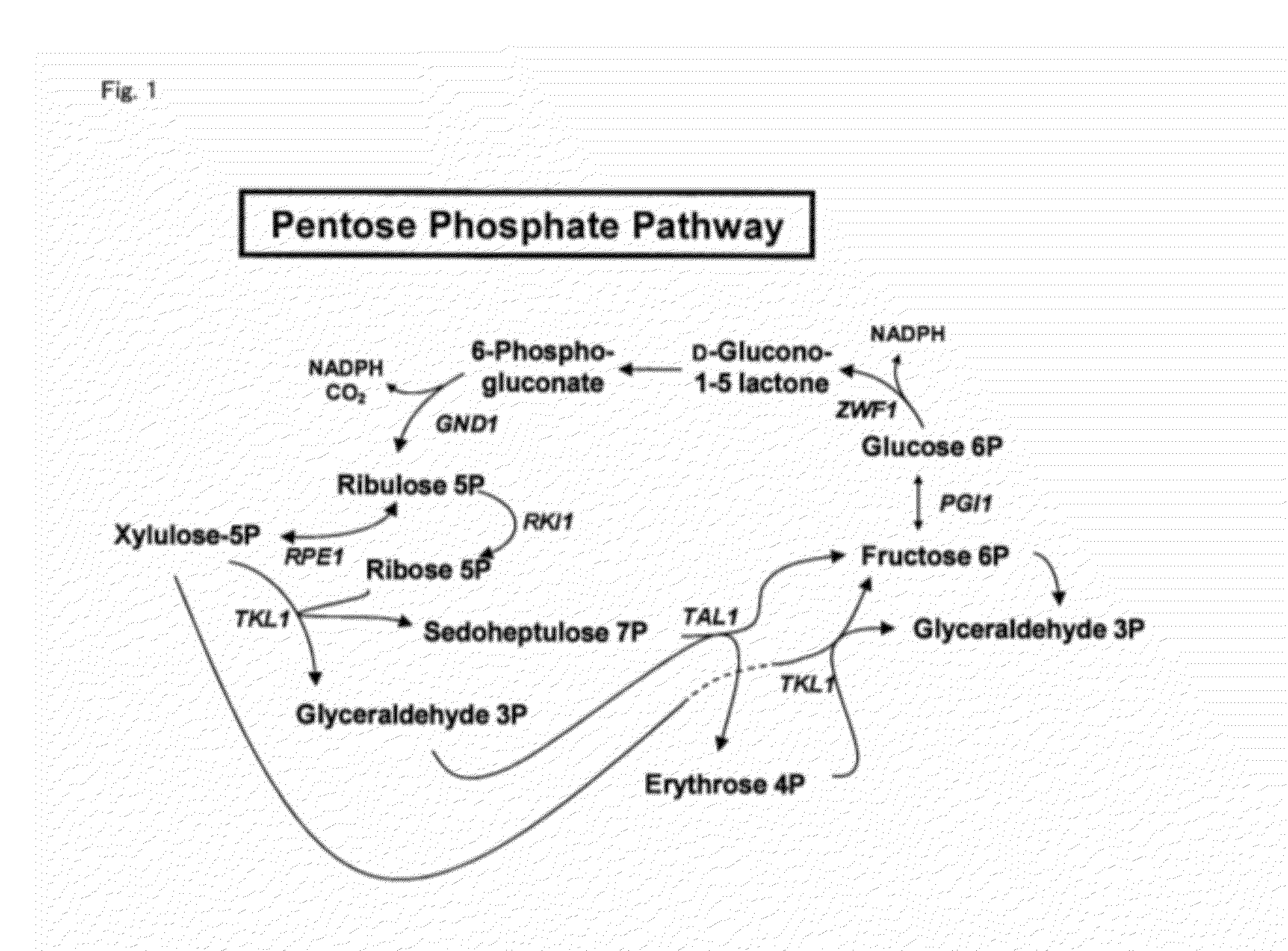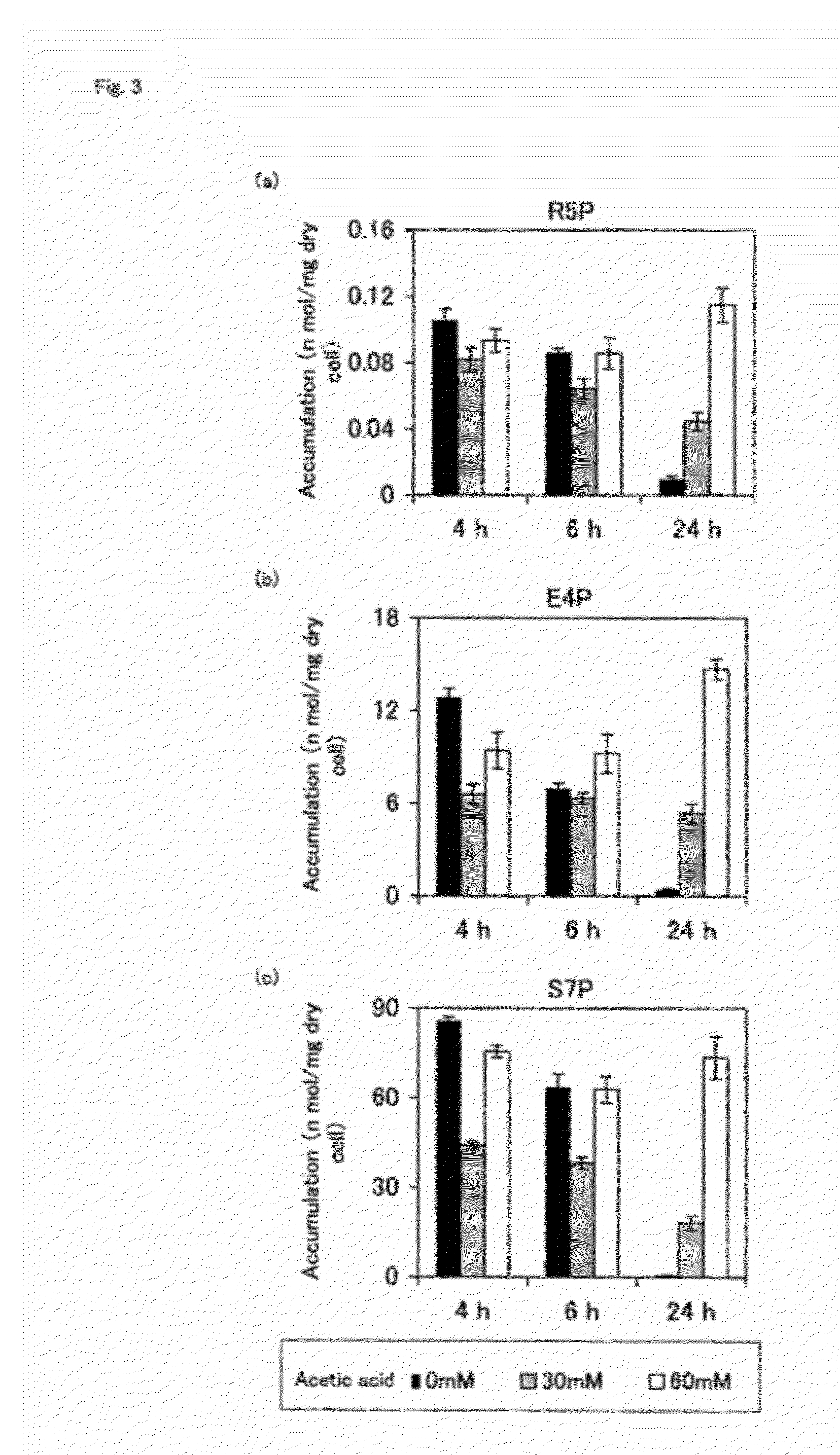Process for production of ethanol from biomass
a technology of biomass and ethanol, which is applied in the direction of biofuels, enzymology, transferases, etc., can solve the problems of low consumption rate, poor ability of occurring yeasts to utilize xylose or arabinose, and competition with food, so as to avoid competition and produce efficient
- Summary
- Abstract
- Description
- Claims
- Application Information
AI Technical Summary
Benefits of technology
Problems solved by technology
Method used
Image
Examples
reference example 1
Fermentation Test and Metabolism Analysis for Yeast MN8140X Strain
[0054](Fermentation Test)
[0055]Into both MT8-1 strain (MATa) (obtained from the National Institute of Technology and Evaluation) and NBRC1440 strain (MATa) (obtained from the National Institute of Technology and Evaluation) of Saccharomyces cerevisiae, the plasmid pIUX1X2XK for imparting a xylose-utilizing ability (prepared as described in S. Katahira et al., Appl. Microbiol. Biotechnol., 2006, vol. 72, pp. 1136-1143 as the plasmid for coexpressing xylose reductase (XR) and xylitol dehydrogenase (XDH) derived from Pichia stipitis and xylulokinase (XK) derived from Saccharomyces cerevisiae) was introduced by lithium acetate treatment, and the two resulting transformed yeasts were then conjugated by mating to obtain a diploid transformed yeast MN8140X strain. This xylose-utilizing yeast MN8140X strain was used to carry out ethanol fermentation from xylose.
[0056]The influence of acetic acid was investigated as the condit...
example 1
Preparation of Plasmid for Overexpression of TAL1 or TKL1
[0064]In an attempt to avoid the accumulation of R5P, E4P, or S7P, a plasmid was constructed for overexpression of the gene for transaldolase (TAL) or transketolase (TKL), which is the enzyme considered to be involved in the metabolism thereof.
[0065]A plasmid pGK404-TAL1 (FIG. 4(a)) was prepared by inserting Saccharomyces cerevisiae TAL1 gene (SEQ ID NO. 1) between the promoter and the terminator of a plasmid pGK404 (FIG. 4(b); prepared as described in J. Ishii et al., J. Biochem., 2009, vol. 145, pp. 701-708), which has a PGK promoter and a PGK terminator. The TAL1 gene used for insertion was prepared by preparing a DNA fragment by PCR as commonly conducted using primers ScTAL-SpeI-F (SEQ ID NO. 3) and ScTAL-BamHI-R (SEQ ID NO. 4) with as a template a genomic DNA extracted from Saccharomyces cerevisiae MT8-1 strain (MATa) according to the commonly used procedure, and treating this fragment with restriction enzymes SpeI and Ba...
example 2
Preparation of TAL1 or TKL1 Overexpressing Strain
[0067]The plasmid pGK404-TAL1 or pGK404 prepared in Example 1 was treated with a restriction enzyme EcoRV to cleave Trp1 gene into a linearized form.
[0068]The plasmid pGK405-TKL1 or pGK405 prepared in Example 1 was treated with a restriction enzyme EcoRV to cleave LEU2 gene into a linearized form.
[0069]Into a transformant obtained by introducing a plasmid pIUX1X2XK into Saccharomyces cerevisiae MT8-1 strain (MATa), the linearized plasmid was introduced by lithium acetate treatment to obtain the strains: MT8-1 / pIUX1X2XK / pGK404-TAL1 (PGK404 / TAL1 strain), MT8-1 / pIUX1X2XK / pGK404 (PGK404 (control) strain), MT8-1 / pIUX1X2XK / pGK405-TKL1 (PGK405 / TKL1 strain), and MT8-1 / pIUX1X2XK / pGK405 strain (PGK405 (control) strain. The PGK404 / TAL1 strain and the PGK404 (control) strain were cultured in SD-UW solid medium (6.7 g / L of Yeast Nitrogen Base without Amino Acids [manufactured by Difco], 20 g / L of glucose, 0.02 g / L of uracil, 0.02 g / L of tryptophan...
PUM
| Property | Measurement | Unit |
|---|---|---|
| temperature | aaaaa | aaaaa |
| temperature | aaaaa | aaaaa |
| temperature | aaaaa | aaaaa |
Abstract
Description
Claims
Application Information
 Login to View More
Login to View More - R&D
- Intellectual Property
- Life Sciences
- Materials
- Tech Scout
- Unparalleled Data Quality
- Higher Quality Content
- 60% Fewer Hallucinations
Browse by: Latest US Patents, China's latest patents, Technical Efficacy Thesaurus, Application Domain, Technology Topic, Popular Technical Reports.
© 2025 PatSnap. All rights reserved.Legal|Privacy policy|Modern Slavery Act Transparency Statement|Sitemap|About US| Contact US: help@patsnap.com



